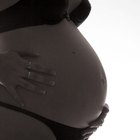Causes of the Baby Not Moving Much at Twenty-Three Weeks Pregnant
Sometime in the second trimester, after the 14th week of pregnancy, a mother may begin to feel her baby move. As time goes on the movement becomes more noticeable. The movement of the baby is comforting as the mother can be reassured that everything is going well in the womb. When the baby moves less as the pregnancy progresses it can become alarming to its mother, but not this does not always signal that something is wrong.
Sleeping
In normal pregnancies, the American Pregnancy Association explains that physicians recommend kick counts at 28 weeks along in pregnancy but 24 weeks for complicated pregnancies. One way of performing the kick counts is to see how much time it takes the baby to make 10 movements. The American Congress of Obstetricians and Gynecologists suggests doing this after a meal and at least once per day. Babies tend to sleep for 20 to 40 minutes at a time. If the baby does not move during kick counts, try again later. It is possible that baby is just sleeping. It can take up to two hours for some babies and only 15 minutes for others to make 10 movements that the mother can notice.
Stillbirth

When Does Your Baby Start Moving Inside the Womb?
Learn More
Stillbirth occurs when the baby unexpectedly dies after the 20th week of pregnancy. More than half of these deaths occur after the 28th week. In 5,000 stillbirths examined, 50 percent of the women noticed a gradual decrease in movement several days before the baby's death, according to the American Pregnancy Association. Performing kick counts can increase the timeliness of a medical intervention but stillbirth is not always avoidable.
Familiarity
When the baby first begins kicking the mother will likely notice nearly every movement. As time goes on, she may become so familiar with the movement that she no longer notices it as prominently as before. This can lead the mother to conclude that the baby has stopped being active. Continuing kick counts provides one way of helping reassure the mother that she has just become accustomed to the movement. Medical personnel can perform a fetal non-stress test to provide even more proof that baby is doing just fine. During the test, medical staff places a monitor on the mother's belly and a Doppler listening device. Together this will allow the mother and practitioner to hear the heart beat and see the movement of the baby on a chart.
Intrauterine Growth Restriction

Sharp Pain in the Cervix With Fetal Movement
Learn More
Intrauterine growth restriction, or IUGR, occurs when the baby is smaller than normal during pregnancy. FamilyDoctor.org suggests that numerous things may cause growth restriction, including maternal illness, alcohol or drug use and placenta deformities. A baby that is small for gestational age may move just as frequently as a normal-sized baby, but the mother may have a harder time feeling the movements. In a first pregnancy the movements are felt sometime after the 18th week. The 23rd week of pregnancy proves fairly early so the mother of a smaller baby may not feel its movements as readily.
Baby Position
The baby's location in the womb at 23 weeks along can impact the mother's ability to feel movements. Should the baby face towards the mother's spine, the movements may not reach the mother's abdomen or sides. As the baby grows, the limbs can stretch out far enough for the mother to feel every movement. At 23 weeks, this does not present a reason for concern.
Anterior Placenta
An anterior placenta is one that rests in front of the baby or closest to the mother's belly button. When the baby is behind the placenta the mother may not feel movement as easily.











